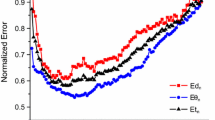Abstract
Background: The site of atrioventricular pre-excitation can roughly be estimated with the help of schemes basing on a few number of electrocardiogram (ECG) leads. Computer algorithms have been developed which utilize the body surface mapping of the pre-excitation signal for the localization purpose. We tested several new algorithms. Method: A patient suffering from Wolff–Parkinson–White syndrome was investigated prior the catheter ablation. The body surface mapping was performed with a 62-lead magnetocardiograph. The site of pre-excitation was calculated by using different methods: the dipole method with fixed and moving dipoles, the dipole scan on the endocardium, and different current density methods (L1 norm method, L2 norm method, low resolution electromagnetic tomography (LORETA) method, and maximum entropy method). Three-dimensional (3D) magnetic resonance imagings (MRIs) of the heart were used to visualize the results. The source positions were compared to the site of catheter ablation. Results: The accessory pathway was successfully ablated left laterally. This site was correctly identified by the conventional dipole method. By scanning the entire endocardial surface of the heart with the dipole method we found a circumscribed source area. This area too, was located at the lateral segment of the atrio-ventricular grove. The current density methods performed differently. Whereas the L1 norm identified the site of pre-excitation, the L2 norm, the LORETA method and the maximum entropy method resulted in extended source areas and therefore were not suited for the localization purpose. Conclusion: The dipole scan and the L1 norm current density method seem to be useful additions in the computational localization of pre-excitation syndromes. In our single case study they confirmed the localization results obtained with the dipole method, and they estimated the size of the suspected source region.
Similar content being viewed by others
References
Wolff L, Parkinson J, White P. Bundle branch block with short P-R interval in healthy young people prone to paroxysmal tachycardia. Am Heart J 1930; 5: 685.
Munger TM, Packer DL, Hammill SC, et al. A population study of the natural history of Wolff-Parkinson-White syndrome in Olmstedt County, Minnesota. Circulation 1993; 87: 1953-1989.
Guize L, Soria R, Charouat JC, et al. Prévalence et évolution du syndrome de Wolff-Parkinson-White dans une population de 138 048 subjets. Ann Med Interne 1985; 136: 474.
Arruda MS, McClelland JH, Wang X, et al. Development and validation of an ECG algorithm for identifying accessory pathway ablation site in Wolff-Parkinson-White syndrome. J Cardiovasc Electrophysiol 1998; 9(1): 2-12.
Fitzpatrick AP, Gonzales RP, Lesh MD, et al. New algorithm for the localization of accessory atrioventricular connections using a baseline electrocardiogram. Am Coll Cardiol 1994; 23(1): 107-116.
Makijarvi M, Nenonen J, Leinio M, et al. Localization of accessory pathways in Wolff-Parkinson-White syndrome by high-resolution magnetocardiographic mapping. J Electrocardiol 1992; 25(2): 143-55.
Nomura M, Nakaya Y, Saito K, et al. Noninvasive localization of accessory pathways by magnetocardiographic imaging. Clin Cardiol 1994; 17(5): 239-44.
Moshage W, Achenbach S, Gohl K, Bachmann K. Evaluation of the non-invasive localization accuracy of cardiac arrhythmias attainable by multichannel magnetocardiography (MCG). Int J Card Imaging 1996; 12(1): 47-59.
Pascual-Marqui RD, Lehmann D, Koenig T, et al. Low resolution brain electromagnetic tomography (LORETA) functional imaging in acute, neuroleptic-naive, first-episode, productive schizophrenia. Psychiatry Res 1999; 90(3): 169-179.
Mosher JC, Lewis PS, Leahy RM. Multiple dipole modeling and localization from spatio-temporal MEG data. IEEE Trans Biomed Eng 1992; 39(6): 541-557.
Fuchs M, Wagner M, Kohler T, Wischmann HA. Linear and nonlinear current density reconstructions. J Clin Neurophysiol 1999; 16(3): 267-295.
Doessel O, David B, Fuchs M, et al. A modular approach to multichannel magnetometry. Clin Phys Physiol Meas 1991; 12(B): 75-79.
Tenner U, Haueisen J, Nowak H, et al. Source localization in an inhomogeneous physical thorax phantom. H Phys Med Biol 1999; 44(8): 1969-1981.
Fuchs M, Wischmann HA, Wagner M, Krüger J. Coordinate system matching for neuromagnetic and morphological reconstruction overlay. IEEE Trans Biomed Eng 1995; 42(4): 416-420.
Fuchs M, Wagner M, Kohler T, Wischmann HA. Linear and nonlinear current density reconstructions. J Clin Neurophysiol 1999; 16(3): 267-295.
Baillet S, Garnero L. Bayesian approach to introducing anatomo-functional priors in the EEG/MEG inverse problem. IEEE Trans Biomed Eng 1997; 44(5): 374A-385A.
Huang M, Aaron R, Shiffman CA. Maximum entropy method for magnetoencephalography. IEEE Trans Biomed Eng 1997; 44(1): 98-102.
Mäkijärvi M, Nenonen J, Leiniö M, et al. Localization of accessory pathways in Wolff-Parkinson-White syndrome by high-resolution magnetocardiographic mapping. J Electrocardiol 1992; 25(2): 143-155.
Moshage W, Achenbach S, Göhl K, Bachmann K. Evaluation of the non-invasive localization accuracy of cardiac arrhythmias attainable by multichannel magneto-cardiography (MCG). Int J Card Imaging 1996; 12(1): 47-59.
Hren R, Zhang X, Stroink G. Comparison between electrocardiographic and magnetocardiographic inverse solutions using the boundary element method. Med Biol Eng Comput 1996; 34(2): 110-114.
Weismüller P, Abraham-Fuchs K, Schneider S, Richter P, et al. Magnetocardiographic non-invasive localization of accessory pathways in the Wolff-Parkinson-White syndrome by a multichannel system. Eur Heart J 1992; 13(5): 616-622.
Mosher JC, Lewis PS, Leahy RM. Multiple dipole modeling and localization from spatio-temporal MEG data. IEEE Trans Biomed Eng 1992; 39(6): 541-557.
Pascual Marqui RD, Michel CM, Lehmann D. Low resolution electromagnetic tomography: a new method for localizing electrical activity in the brain. Int J Psychophysiol 1994; 18(1): 49-65.
Clarke CJS, Janday BS. The solution of the biomagnetic inverse problem by maximum statistical entropy. Inverse Problems 1989; 5: 483-500.
Ioannides AA, Bolton JPR, Clarke CSJ. Continuous probabilistic solutions to the biomagnetic inverse problem. Inverse Problems 1990; 6: 523-542.
Author information
Authors and Affiliations
Rights and permissions
About this article
Cite this article
Leder, U., Haueisen, J., Pohl, P. et al. Methods for the computational localization of atrio-ventricular pre-excitation syndromes. Int J Cardiovasc Imaging 17, 153–160 (2001). https://doi.org/10.1023/A:1010606030369
Issue Date:
DOI: https://doi.org/10.1023/A:1010606030369



